#Amphibious Assault Ship
Text

"Recovery swimmer attaching the flotation collar around the Apollo 14 capsule (CM-110), with the still-attached parachute lines still visible."
Date: February 9, 1971
NASA ID: 71HC-245
#Apollo 14#Apollo CSM Block II#CSM-110#Kitty Hawk#NASA#Apollo Program#H-type mission#Splash down#Splashdown#Recovery#USS NEW ORLEANS (LPH-11)#USS NEW ORLEANS#Iwo Jima Class#Amphibious Assault Ship#Pacific Ocean#United States Navy#US#Navy#USN#February#1971#my post
79 notes
·
View notes
Text

USS Boxer (LPH-4, ex-CV-21) underway during exercise Steelpike I, in October 1964.
USS Boxer was one of the few Essex class carriers not modified with an angled deck after WWII. She was instead extensively modified to a Landing Platform Helicopter carrier in the late 1950s.
Photographed from USS Rigel (AF-58).
source
#USS Boxer (LPH-4)#USS Boxer (CV-21)#Essex Class#Boxer Class#Aircraft Carrier#amphibious assault ship#Vietnam War#warship#ship#boat#us navy#united states navy#navy#usn#u.s. navy#color photo#my post
41 notes
·
View notes
Photo

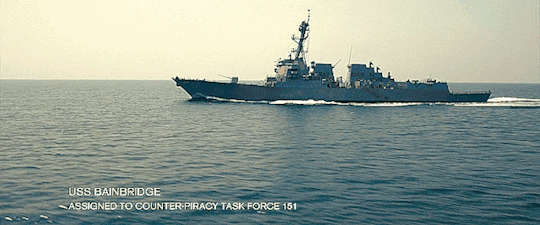







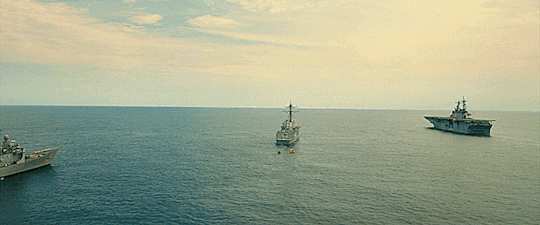
Arleigh Burke-class USS Bainbridge (played by sister ship USS Truxtun), Wasp Class USS Boxer and Oliver Hazard Perry-Class USS Halyburton, Captain Phillips (2013)
#Captain Phillips#USN#USS Bainbridge#USS Truxtun#USS Boxer#USS Halyburton#warship#Arleigh Burke Class Destroyer#Wasp Class#Oliver Hazard Perry Class#Destroyer#Amphibious Assault Ship#Frigate#captainphillipsedit#GIF#my gifs#Danny watches Captain Phillips#Hide and Queue
26 notes
·
View notes
Photo
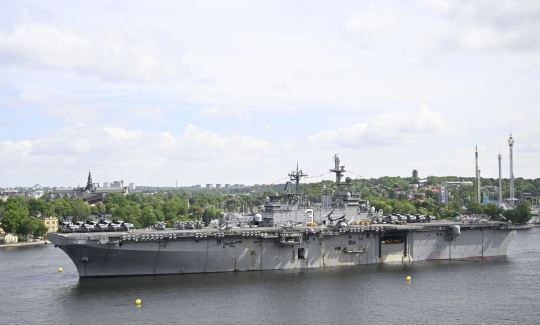
USS Kearsarge in Stockholm, Sweden, 2022. Source: https://www.seattletimes.com/nation-world/u-s-warship-arrives-in-stockholm-for-military-exercises-and-as-a-warning/
U.S. amphibious assault ship USS Kearsarge is seen in central Stockholm, Friday. Around 40 warships are expected to moor in Stockholm from June 2-5, ahead of the Baltops 22 exercise taking place June 5-17. (Henrik Montgomery / The Associated Press
#Sweden#Stockholm#USS Kearsarge#amphibious assault ship#ship#Baltic Sea#Northern Europe#defense of europe#defense of freedom#naval history#very good news#Baltops 22
2 notes
·
View notes
Text
#4DModel #type075lhd #type075amphibiousassaultship #yushenclass #modelship #modelbuilding
instagram
#4D Model#type 075 LHD#Yushen Class#Landing Helocopter Dock#Type 075 Amphibious Assault Ship#model ship#model building#original content#Instagram
0 notes
Text

A V-22 Osprey aircraft from the "Thunder Chickens" of Marine Medium Tiltrotor Squadron 263 takes off from the multi-purpose amphibious assault ship USS Bataan. Bataan is conducting routine operations in the Atlantic Ocean. USNORTHCOM, AT SEA
07.08.2008
Photo by Petty Officer 3rd Class Patrick Gearhiser
149 notes
·
View notes
Text

The USS Iwo Jima (LHD 7) - A Vital Component of the Wasp Class, Standing Strong as an Amphibious Assault Ship
25 notes
·
View notes
Text
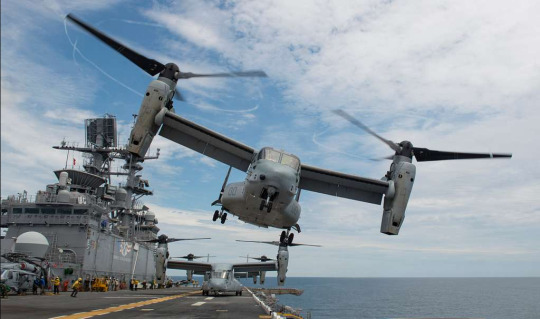
A USMC MV-22 lifting off the US Navy amphibious assault ship USS Iwo Jima in the Atlantic Ocean
47 notes
·
View notes
Text

U.S. Marines conduct weapons training aboard amphibious assault ship USS Bataan (LHD 5) in the Gulf of Aden, Aug. 11, 2023. Components of the Bataan Amphibious Ready Group and 26th Marine Expeditionary Unit are deployed to the U.S. 5th Fleet area of operations to help ensure maritime security and stability in the Middle East region.
(Photo by Sgt. Matthew Romonoyske-Bean)
55 notes
·
View notes
Text



"Apollo 14 crew members sit in a life raft beside their Command Module (CM-110) in the South Pacific Ocean as they await a U.S. Navy helicopter SH-3A Sea King from Anti-Submarine Squadron Six (HS-6), which will take them aboard the USS NEW ORLEANS (LPH-11), prime recovery ship. The crew men are, from left to right, astronauts Alan B. Shepard Jr., commander; Stuart A. Roosa, command module pilot; and Edgar D. Mitchell, lunar module pilot. Two U.S. Navy underwater demolition team swimmers (one partially visible in the right upper corner) assist in the recovery operations."
Date: February 9, 1971
Naval History and Heritage Command: USN 1146625
NASA ID: S71-19475
#Apollo 14#Apollo CSM Block II#CSM-110#Kitty Hawk#NASA#Apollo Program#H-type mission#Splash down#Splashdown#Recovery#USS NEW ORLEANS (LPH-11)#USS NEW ORLEANS#Iwo Jima Class#Amphibious Assault Ship#Pacific Ocean#United States Navy#US#Navy#USN#February#1971#Sikorsky SH-3 Sea King#SH-3#Helicopter#Helicopter Anti-Submarine Squadron Six#HS-6#my post
65 notes
·
View notes
Text
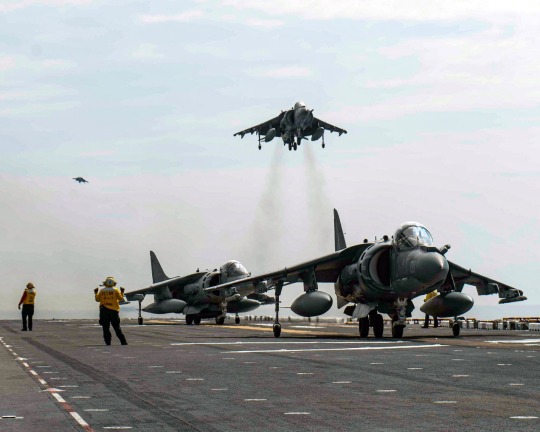
AV-8B Harriers, assigned to the “Tomcats” of Marine Attack Squadron (VMA) 311 on the amphibious assault ship USS Bonhomme Richard (LHD 6). June 2017. (mcssa Gavin Shields)
@kadonkey via X
46 notes
·
View notes
Text

Marines Doing Jumping Jacks on Amphibious Assault Ship USS New Orleans, Aug. 1982
19 notes
·
View notes
Text

The Pentagon is deploying two carrier strike groups, eleven Burke-class destroyers, a number of Ticonderoga-class cruisers, amphibious assault ships, THAAD and Patriot missile defense systems, multiple squadrons of fighter jets, strategic bombers, and undisclosed assets to the Middle East.
The Pentagon expects Iranian proxies to continue to target U.S. troops in the region and has already stated that they will respond "decisively."
What's the probability that this escalates into a war between the United States and Iran?
PENTAGON: "Between October 17th and the 24th, U.S. and coalition forces have been attacked at least ten separate times in Iraq and three separate times in Syria via a mix of one-way attack drones and rockets...
We know that the groups conducting these attacks are supported by the IRGC and the Iranian regime. We are seeing the prospect for more significant escalation against U.S. forces and personnel across the region in the near term coming from Iranian proxy forces and, ultimately, from Iran.
So, by virtue of our announcement over the weekend, we are preparing for this escalation, both in terms of defending our forces and responding decisively."
27 notes
·
View notes
Text
A Thing Of Vikings Chapter 110: A Unity Of View

Chapter 110: A Unity Of View
Bewilderbeast: Tidal-Class dragon
Overview: Amphibious-aquatic infrastructural/industrial dragon. In modern economies, they are helpful with construction of aquatic and submersible infrastructure and mining, as well as offering chemical and traditional refrigeration services. Militarily useful primarily in naval defense, as their speed is too slow to keep pace with a modern fleet, but are extremely useful for securing harbors and amphibious landing zones when called for.
Breath Type: Flash-Frozen water mixed with Ammonium Nitrate.
Identification: Medium to Gargantuan size. White, gray or black scales and hide, studded with large blunt spines along the back, neck, and tail, holding up a vestigial pair of wings along the lateral sides of the thorax. Four pillar-like legs. Two large tusks jut forward from the temples, aiding in water streamlining during swimming. Long tail with wide fin at terminal end, supported by more spikes. Overall teardrop body profile.
Strategic Role: Naval auxiliaries, submersible ship protection, mine-sweeping, submarine hunters, logistical support, construction support, amphibious assault support.
Known Weaknesses: Slow speed, semi-obligate aquatic, with larger individuals able to spend increasingly less time out of water without risk of harm. Modern mines and torpedoes can easily penetrate their hide in the absence of armor or countermeasures. Needs to breathe.
Phenotype Cluster: B5F3+SØSØSØT7+T5!
Populations: Moderate, but restricted to coastal and riverine regions, for obvious reasons.
—North Sea Empire, Office of Draconic Intelligence, Dragon Breed Profiles (Declassified), 1822 Edition
AO3 Chapter Link
~~~
My Original Fiction | Original Fiction Patreon
11 notes
·
View notes
Text

A U.S. Marine conducts fast rope training aboard the Wasp-class Amphibious assault ship USS Bataan (LHD 5) during Amphibious Ready Group/MEU Exercise, Atlantic Ocean.
The U.S. Marine Corps photo by Cpl. Kyle Jia (2023).
#military 1st#army#military#marine#us marines#us marine corps#u.s. marine corps#united states marines
27 notes
·
View notes
Note
Hi! I have a battle scene that takes place on the coast and a few questions concerning the practical positioning. The defending side A 's cavalry are one of their biggest strengths and include a small section of rare transformative horses that can swim and breath under water. They stand on the coast and surrounding fields. If B, on the offense, arrive on the beach on boats how would A position their cavalry and infantry?
I'm not sure if there is any use in having cavalry on the beach facing the offense. Would they likely position their infantry first facing the sea with their cavalry further behind them i.e. where mounted archers can attack from and move around quickly. Depending on the geography could mounted soldiers charge B's troops once they reach the beach? Or would it just be impractical for the horses (the non-fantasy ones).
The setting is Tolkein-similar medieval fantasy with some more advanced technology in the works.
So, the first thing that comes to mind is that transporting horses by sea is notoriously difficult. I'm not an expert on horse transportation, but from what I remember the stress of transport alone can be fatal, on top of that, their legs and lungs are especially vulnerable while at sea. Finally, getting horses ashore without a full port is going to be extremely difficult without modern amphibious landing craft. So, it's not easy for an amphibious assault force (your second faction), to bring cavalry. Somewhat obviously, if their cavalry doesn't involve living horses, some of these problems may not apply. (Either fantasy animals who have no issues with being cooped up on a ship for weeks at a time, or the undead, or something else entirely.)
With all that said, it is possible to transport horses by sea, but it is difficult. Also, it occurs to me, after writing this, that you specify if the second group had cavalry.
The transforming horses (kelpies, or whatever), might not have an issue with being aboard a ship, and may be able to embark and disembark mid-voyage. It's kind of hard to tell. Depending on how far they can clear the water, they might be useful for eliminating enemy landing craft before they can come ashore. You wouldn't even need that many of them to sufficiently cripple an invading force, unless the capital ships were specifically set up to deal with them and protect their their landing crafts. If the assaulting force didn't know about the horses, they may even be able to take out the capital ships before dealing with the landing troops.
I'm not sure how well horses take to sand, but for infantry, quickly moving on beach sand can be a lot more exhausting than you'd expect.
Historically, amphibious assaults, that is to say, attacking from the sea, is an extraordinarily difficult tactic. These forces are especially vulnerable while disembarking. They're likely to still be reorganizing themselves back into their units. They have their back to the sea, meaning they cannot fall back, and they cannot move forces behind their front line. They are stuck with their distribution of forces. And worse, their chain of command is likely to be somewhat disorganized as well. A lot of modern concepts about amphibious warfare are, just that, “modern,” and have been around for slightly over a century.
Spears and pikes are effective anti-cav weapons, so if the invading troops expect a cavalry as part of their initial retaliation, they can prepare for that.
But, I think, absent additional information, the answer on how to position their forces would be to simply send in their infantry immediately, before the invading force was able to finish disembarking, and cut them down, sending their transforming horses out any reinforcements or supports coming from the invader's ships. It's not even a positioning issue in this case, it's just about driving them back into the sea before they're organized and ready to fight.
-Starke
This blog is supported through Patreon. Patrons get access to new posts three days early, and direct access to us through Discord. If you're already a Patron, thank you. If you’d like to support us, please consider becoming a Patron.
#How to fight write#Starke answers#writing advice#writing reference#writing tips#In Scottish Myth Kelpies Drowned Their Riders
55 notes
·
View notes